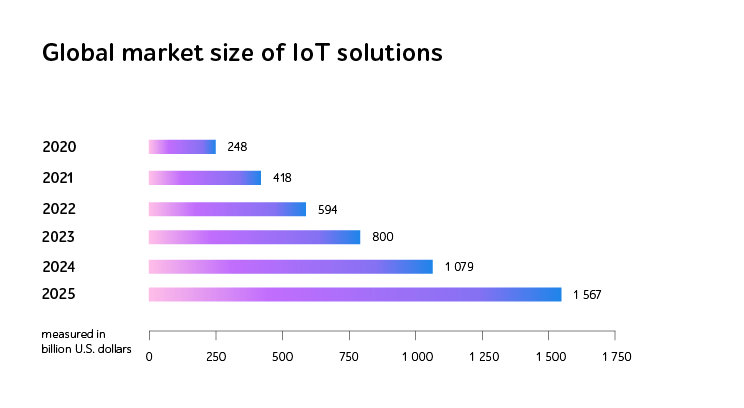
Watch out for 6 telecom trends and QA tips to implement them
By making literally everyone shift to online ecosystems and reimage IT strategies, 2020 has turned the tide in the telecommunications industry. What to expect in 2021 and how to get prepared for it?
The answer lies in keeping with times and implementing tech trends that help sustain and strengthen competitive advantage.
Welcome to our overview of 6 emerging trends in telecom and how to introduce them with ease and confidence through QA and software testing best practices.
Top 6 trends of the telecommunications industry
By easing people’s lives and shifting operations to a virtual space, customers’ habits have changed and made their behavior more meticulous.
The telecom industry is no exception, as today, stable network connectivity is an inevitable part of any IT product. To delight end users, companies implement novel opportunities by turning to tech trends. Let’s have a closer look at the top 6 trends of 2021 in the industry that may help win the competition.
Trend 1. Applying total digitalization
Due to digital transformation happening globally, telecom companies benefit from modifying traditional services. For instance, having entered the media and entertainment industry, telecom-based OTT (over the top) media has become more common than traditional TV packages.
Moving to online ecosystems has also triggered enabling cloud possibilities that help keep up with the swift alterations in the IT market.
Trend 2. Implementing hyperautomation
Since 2019, the global automation market has grown by $28.3, and companies are embarking on digital operational excellence to a greater extent. This is where hyperautomation comes into play while covering entire business ecosystems as well as creating fully automated value chains.
Once having optimized the documents, functional tasks, work in production, etc., businesses become ensured of both the total digitalization and operational resiliency of an organization.
Trend 3. Spreading 5G network
Quarantine and lockdown measures have drastically restrained ubiquitous 5G usage. However, 2021 will be the year of this technology’s prosperity. Thanks to its low latency and strengthened throughput, this tech trend may cover 45% of the world by 2025 encompassing more than 1.7 billion devices (according to PwC report on the Global Entertainment & Media Outlook).
With such potential, 5G can turn into a classic means of connectivity. Once having implemented 5G, some telecom services vendors are already working their way into 6G technology.
Trend 4. Distributing edge computing
Applying innovative 5G networks, cloud storage, and numerous smart devices attribute to rapid data growth. The volume of data is increasing, and central processing servers can no longer cope with that.
Thus, telecom companies are drawing more attention to distributed computing with local assets allowing optimizing throughput and reducing response time.
According to IDC’s predictions for the worldwide IT industry in 2021, organizations will direct 80% of their capital to the advanced capabilities at the edge of the network in 2021. Despite 2020 having already become the year of the edge computing breakthrough, the future of innovation has no limits.
Trend 5. Supporting a new era of IoT
Global telecommunications coverage makes the concept of IoT more accessible. According to Statista, the worldwide IoT market size is expected to grow by over $1,500 bln in 2025. By uniting gadgets into a common network, they provide users with the next generation of services — combined communication networks.

Source: Statista
In 2020, Gartner’s analysts coined the term “Internet of Behaviors” (IoB) in their report of Top Strategic Technology Trends for 2021. It is related to continuously connecting people to virtual ecosystems.
In the past few years, creating a smart network was simply a feature of gadgets, but today, it is available for real users. This global communication format requires an advanced and secure technological base owing to its complexity.
Trend 6. Discovering benefits of total experience
Total experience combines traditionally disparate disciplines like multi-experience (MX), customer experience (CX), employee experience (EX), and user experience (UX) as well as links them to create a better overall experience for all parties.
Previously, companies were developing business tasks based on individual user experience. Now, the practice of general experience allows for developing more flexible interactions between consumers and businesses. Due to this unification, one may reduce the long-term costs of project development and maintenance.
4 QA hints to implement telecom trends
Providing a high level of software quality is another cornerstone of enabling business success. As the rigorous race in the market, time and budget limits have become common issues on telecommunications projects, companies need to include QA to a much higher extent.
We’ve prepared a one-stop playbook of QA hints that may address the challenges and contribute to business growth.
Hint 1. Strengthen QA practices
By being strongly focused on satisfying end users’ needs, telecom companies strive to enable flawless customer experience and secure data flow. To provide impeccable quality of IT solutions with complex business logic and infrastructure, organizations should introduce smarter and more automated QA and software testing practices.
More noteworthy is the ability to maintain and empower the QA culture. By realizing the necessity to enhance QA activities at both company and team levels, one can reach desired outcomes at short notice.
Thus, more than 80% of the World Quality Report (WQR) 2020-2021 respondents are careful with the necessity to improve QA teams and take a more responsible attitude to the software quality.
Hint 2. Apply Agile
Suitable methodology meeting all modern market requirements are amid the core principles of performing software testing successfully. Flexible methods are especially beneficial for telecom companies having solutions dealing with complicated business logic.
According to the WQR, telecom players choose DevOps and shift-left methods for their effectiveness and ability to rapidly adapt to the changing market and timely manage priorities.
Hint 3. Automate wisely
Companies still face multiple difficulties in selecting the necessary test automation tools as well as search for specialists with a suitable skillset: only a third of WQR telecom representatives get ROI by automating checks.
If you are expecting your test automation to optimize test coverage, build a robust QA strategy and identify what test cases need to be automated before executing it. This helps provide better control and transparency of testing processes, reduce human errors, and others.
With that, automate-first approaches may be of help by identifying the features likely to change in several weeks and being checked frequently while planning their further automation without manual testing efforts.
In addition to automated testing, it is essential to pay attention to security testing as well as functional and regression checks after introducing any new functionality.
Hint 4. Introduce next-gen QA
AI and ML. They help with balancing out QA activities, predict test quality, prioritize test cases, classify defects, verify voice messaging and data entry, and many more. These advantages of smart systems are becoming especially important in unstable conditions.
AI- and ML-based testing can be handy to be one step ahead and keep the lead in the market in unstable conditions by contributing to improving overall efficiency on the project, reducing risks, and increasing team flexibility.
Summing up
Bearing in mind further computerization and ever-growing optimization of user experiences, relevant telecom trends for 2021 would be 5G networks, edge computing, hyperautomation as well as applying total experience and “Internet of Behaviors.”
However, implementing tech trends falls short to reach planned business outcomes. To deliver top-tier telecom software and win the race, open-minded companies should also consider improving QA practices, applying wise test automation, introducing next-gen QA, and building a strong QA strategy.
Need QA support to enhance your IT solution quality? Get hold of a1qa’s specialists.








